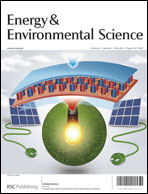In pursuing higher energy density with no sacrifice of power density, a supercapacitor-battery hybrid energy storage device—combining an electrochemical double layer capacitance (EDLC) type positive electrode with a Li-ion battery type negative electrode—has been designed and fabricated. Graphene is introduced to both electrodes: an Fe3O4/graphene (Fe3O4/G) nanocomposite with high specific capacity as negative electrode material, and a graphene-based three-dimensional porous carbon material (3DGraphene) with high surface area (∼3355 m2 g−1) as positive electrode material. The Fe3O4/G nanocomposite shows a high reversible specific capacity exceeding 1000 mA h g−1 at 90 mA g−1 and remaining at 704 mA h g−1 at 2700 mA g−1, as well as excellent rate capability and improved cycle stability. Meanwhile the 3DGraphene positive electrode also displays great electrochemical performance. With these two graphene-enhanced electrode materials and using the best recommended industry evaluation method, the hybrid supercapacitor Fe3O4/G//3DGraphene demonstrates an ultrahigh energy density of 147 W h kg−1 (power density of 150 W kg−1), which also remains of 86 W h kg−1 even at high power density of 2587 W kg−1, so far the highest value of the reported hybrid supercapacitors. Furthermore, the energy density of the hybrid supercapacitor is comparable to lithium ion batteries, and the power density also reaches that of symmetric supercapacitors, indicating that the hybrid supercapacitor could be a very promising novel energy storage system for fast and efficient energy storage in the future.

You have access to this article
 Please wait while we load your content...
Something went wrong. Try again?
Please wait while we load your content...
Something went wrong. Try again?


 Please wait while we load your content...
Please wait while we load your content...